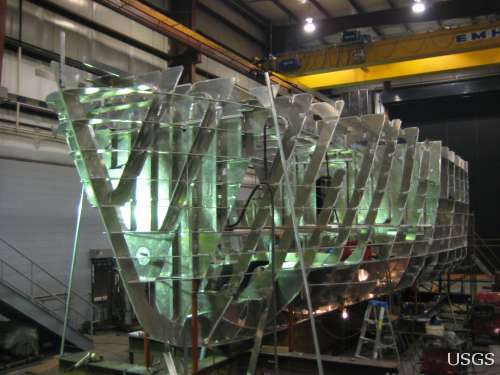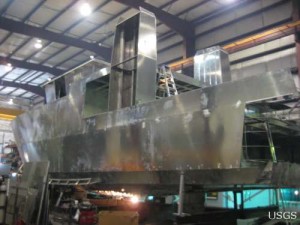By Thea Hassan

The bow of a new U.S. Geological Survey research vessel is constructed by the Great Lakes Towing Company in Cleveland, Ohio. Photo: Tim Cherry, U.S. Geological Survey.
Two new vessels will help government researchers continue to study Great Lakes fisheries.
The U.S. Geological Survey’s Great Lakes Science Center plans for new additions this September when the Muskie replaces the aging Musky II on Lake Erie and the Kaho replaces a vessel of the same name on Lake Ontario.
Among the many threats they will help study is the relationship between lamprey and the lake trout, a primary victim of the parasite.
Research vessels are floating laboratories.
Researchers investigate lake ecology–tracking fish populations or measuring dissolved oxygen content and other water quality variables. Researchers also perform tissue dissections and remove fish ear bones, called otoliths. These procedures provide scientists with information about a species’ age, growth and diet.
Canadian and United States agencies use the information to make management and control decisions according to Richard T. Kraus, Lake Erie Biological Station chief. The station is one recipient of a replacement vessel.
“Having the proper work platform is essential to those kind of work activities,” Kraus said.
The old vessels have cruised the Great Lakes for more than a half-century. Samples in better condition provide more precise results, leading to more accurate research.
The new aluminum vessels will be larger, faster, stronger and travel farther. These advancements also will contribute to the information available for management decisions, Kraus said.
“Greater performance by the boat can produce more data, do more things, and respond to research needs at a far greater [extent] than we had been doing previously,” he said.

The two new vessels will continue to aid researchers tracking fish populations on Lakes Erie and Ontario. Photo: Tim Cherry, U.S. Geological Survey.
One new study planned for the replacement vessel, Muskie, is to study lake trout spawning habitat. The old vessel could not support the remotely operated vehicles needed to study this behavior. The new vessel is equipped with a larger onboard power supply to handle these 21st century demands.
The Muskie will house six people including a boat captain, engineer, fish biologists, scientists, and technicians. Though days spent aboard the research vessel can be arduous, it has its pay offs.
“There are lots of things to see…environmental phenomena to witness, and they can be a part of a really interesting activity that a lot of people don’t get to participate in,” Kraus said.
The Muskie will be able to travel five days and about 600 miles at one time before docking to refuel and discharge waste according to Tim Cherry, the U.S. Geological Survey’s technical representative. The maximum expedition time for the old vessel was 12 hours, and it had to return to port after each journey.
The Great Lakes Towing Company in Cleveland, Ohio is building the new vessels, and expects to complete them by September. About 18 employees work six days a week to meet the deadline.
Funding for the $8.2 million project came from the American Recovery and Reinvestment Act, signed by President Obama in 2009. The purpose of the act is to create new jobs, save existing ones, spur economic growth and increase visibility on how government money is spent.
“Absolutely, it’s helped us keep jobs,” says Tim Singer, the company’s shipyard sales director.
The project will also help the region by protecting the $7 billion annual commercial and sport fish industry in the Great Lakes area by providing information for the management of key species, such as the lamprey and lake trout.
Future use of the old vessels is unknown.
Related stories: Coregonus replaces oldest Great Lakes research vessel, MONDAY MASHUP: Find a GLASS ship
Editor’s note: The original version of this story was corrected June 27, 2011 to indicate that the vessels will research lamprey threats and not directly kill them.
